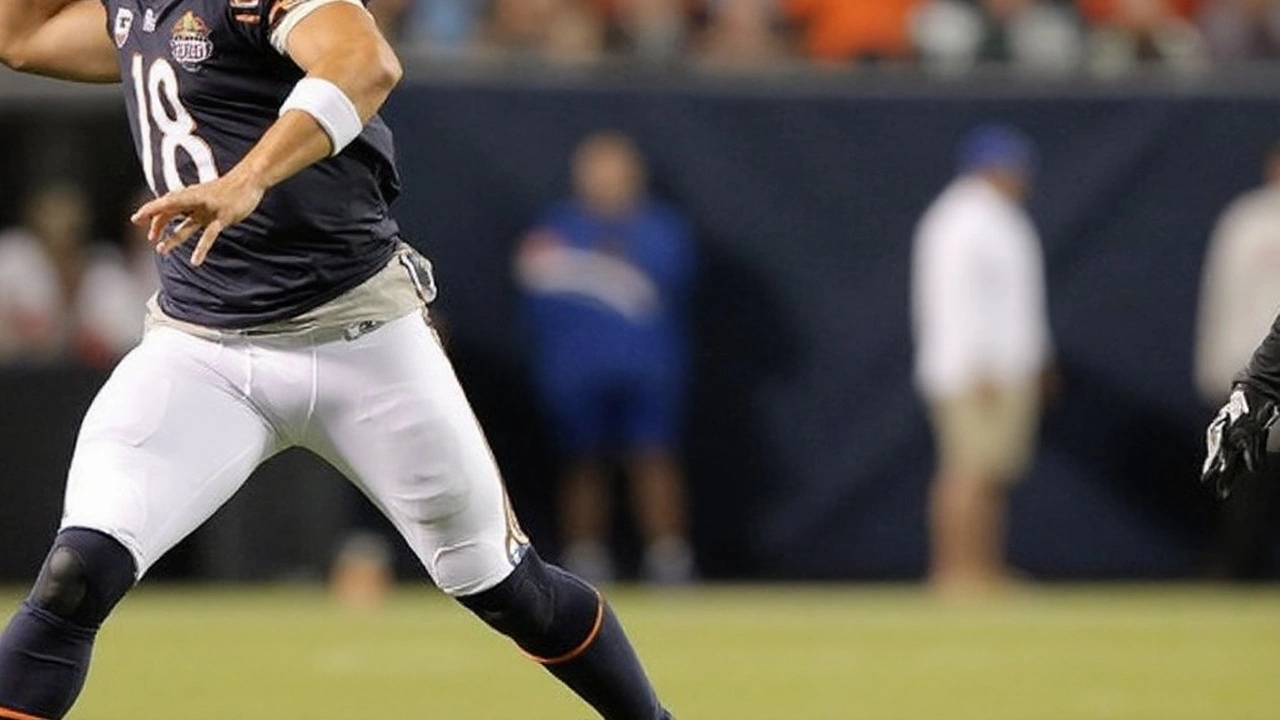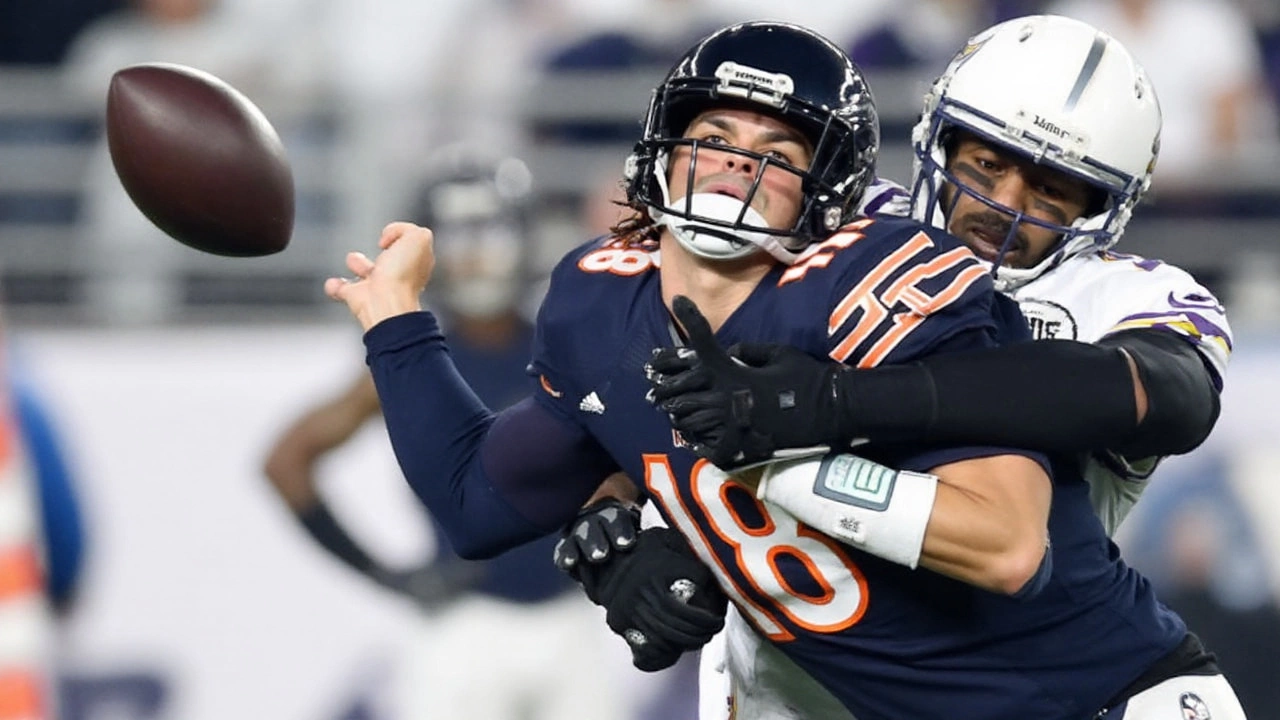Week 1 rarely gives straight answers, and this one might be the murkiest of the bunch. The Minnesota Vikings head to Soldier Field as slight 1.5-point favorites to face the Chicago Bears on Monday Night Football, a divisional opener loaded with quarterback questions, coaching changeovers, and a recent history that tilts purple in Chicago. The market says it’s close. The public says Chicago can steal it. The stage says both young quarterbacks will feel the heat.
Odds, context, and the quarterback questions
The line has Minnesota favored by 1.5 at around -108, which implies a modest edge—barely more than a coin flip. Despite that, the Bears have drawn 56% of the betting action as a home underdog. That split tells you two things: bettors are intrigued by Caleb Williams in Year 2 and they’re skeptical of a rookie quarterback making his first start on the road. Yet the number still leans Vikings, hinting that respected money—or at least the books—trusts Minnesota’s broader roster more.
The Vikings ride into 2025 off a 14-win season, swapping certainty at quarterback for upside. J.J. McCarthy, a 2024 first-rounder, makes his NFL debut a short drive from where he grew up in the Chicago suburbs. He steps into a huddle with real firepower—Justin Jefferson on the perimeter and T.J. Hockenson over the middle—plus a backfield designed to simplify reads and control tempo. That support system matters on a loud night with a lot of eyes and not much margin for error.
Chicago’s story is different. Williams returns with scars and lessons from his rookie year and a new head coach in Ben Johnson, who arrives with a playbook built on spacing, rhythm throws, and clean answers versus pressure. The Bears have the pass-catchers to test a defense at all three levels. D.J. Moore remains the alpha after torching Minnesota at Soldier Field last season (seven grabs, 106 yards), and rookie Rome Odunze brings size and polish as an immediate matchup problem. If Johnson’s structure clicks early, Williams’ reads should be faster and the ball should come out on time.
Local predictions lean Vikings in a grinder. The Star Tribune’s Ben Goessling calls it 17-13 Minnesota, leaning on the visitors’ ability to fluster Williams. From the Pioneer Press, Dane Mizutani (20-17) and John Shipley (21-19) also take the Vikings in one-score games. Purple Insider’s Matthew Coller goes 24-17, citing a deeper roster. The through line from that group: trust Minnesota’s defense to muddy it up and the Vikings’ weapons to find enough answers late.
One more trend looms over the night: Minnesota has won its last five trips to Soldier Field. That building used to be a hornet’s nest for the Vikings. Recently, it’s been a quiet house for the home team when these two meet.
Weather, field conditions, and the jittery rhythm of opening night often create a choppy first half in Week 1 games. Expect a couple of stalled drives, a field position fight, and one early mistake that feels twice as loud because of the stage.

Matchups that could decide it
Start with the obvious: Justin Jefferson vs. Chicago’s secondary. The Bears have the kind of corner in Jaylon Johnson who prefers this kind of fight—physical at the line, patient down the field, and confident in contested spots. Chicago can’t live in single coverage for four quarters, but if Johnson wins enough snaps, it forces McCarthy to live on second reads and checkdowns. That slows the game. That also helps the Bears pass rush find the rookie’s launch point.
Inside, T.J. Hockenson is a problem if he’s featured early. Rookie quarterbacks often lean on tight ends for a reason—quick separation, friendly throwing windows, safe throws when the pocket compresses. If the Vikings spread Chicago out with Jefferson motion and then run Hockenson into vacant zones, the Bears’ linebackers will be stressed to cover grass and rally to tackle.
The run game is where Minnesota can settle McCarthy’s heartbeat. Jordan Mason gives the Vikings a bruising profile on short yardage and at the goal line. Aaron Jones brings the vision and edge speed to punish overpursuit and win on screen designs. A productive timeshare eats clock, shortens the game, and sets up play-action shots that don’t require perfect ball placement from a debuting quarterback.
For Chicago, the passing tree is changing. Johnson’s offense leans into pre-snap tells and quick-game efficiency. That means slants, outs, speed digs, and choice routes to Moore, with Odunze using his frame to win on comebacks and back-shoulder throws. If the Bears stay ahead of the chains, the deep shots will come on Minnesota’s tendency to heat up quarterbacks with pressure looks.
The pass rush and protection battle may be the whole ballgame.
- Chicago’s rush vs. Minnesota’s tackles: Christian Darrisaw and Brian O’Neill are as steady as it gets on the edge. The Bears need disruption up front to make a rookie hurry. If Chicago wins early-down run fits, third-and-long becomes a playground for stunts and simulated pressures.
- Minnesota’s pressure packages vs. Williams: The Vikings don’t hide their intent to attack protections. Expect creepers, mugged A-gaps, late rotations, and blitzes that force hot reads. Johnson will counter with motion tells and built-in answers—swing screens to Jones-type backs if they were on the other sideline; in Chicago’s case, running backs and tight ends releasing to grass—and quick game to Moore and Odunze.
Third down is Williams’ biggest test. Last year, when the pocket got muddy, he could drift or try to make a hero throw. Year 2 is about discipline. Step up. Rip the dig. Live for the next snap. If he strings a couple of conversions together, that’s a signal the system is doing its job and the quarterback is, too.
Red zone? That’s Mason’s world for Minnesota. The Bears will have to win low and late, or the Vikings will grind four-yard carries into touchdowns. For Chicago, condensed windows put a premium on trust throws—back-shoulder to Odunze, glance routes to Moore, and designed keepers that put Williams on the edge with a run-pass option attached.
Special teams can swing a tight game. Week 1 often features a big kick return or a coverage bust because timing isn’t perfect yet. Field goals are not automatic in the wind off the lake at night, and momentum flips fast in primetime when a drive that should end in three points ends in nothing.
The coaching subplot matters. Kevin O’Connell is in system continuity mode—same voice, same language, and a veteran core that knows the beats. The Bears are translating a new playbook on the fly. That doesn’t mean Chicago will be sloppy, but live bullets expose timing issues you can’t see on the practice field. Expect Johnson to script aggressively early, then simplify if protection gets stressed or if Minnesota’s pressure looks start winning on first contact.
Here’s where each team can grab control:
- If Minnesota wins: The Vikings run it efficiently on early downs, Jefferson forces safety help, Hockenson owns the hashes, and McCarthy avoids the backbreaking mistake. A couple of short fields created by defense or special teams would tilt it.
- If Chicago wins: Williams beats the blitz with rhythm throws, Moore and Odunze win one-on-ones on the boundary, and the Bears’ front prevents Minnesota from living in second-and-5. One explosive play—broken tackle, screen that pops, busted coverage—could be enough.
Public vs. price is another subplot. With Minnesota -1.5 and the Bears getting more tickets, the market is telling you the rosters are close, but there’s trust in the Vikings’ execution. At -108, the break-even probability is just under 52%, which fits the “slight favorite” tag. Local media sees a low total game; their score predictions cluster in the high teens and low 20s. That lines up with Week 1 tendencies: defenses usually play faster than offenses before timing and chemistry catch up.
Personnel chess pieces to watch:
- Jefferson’s usage: Motion, stacks, and bunch sets can prevent a clean press at the line. If Minnesota gets him free access snaps, Chicago will have to roll help and live with a lighter box.
- Moore in the slot: Moving him inside can create leverage against zones and slower matchups on option routes. If the Bears are hunting easy yards, that’s where they come from.
- Screen game: Both teams can weaponize it. For Minnesota, it calms a debuting QB and punishes aggressive rush looks. For Chicago, it’s a pressure check—if the Vikings blitz, the ball goes right behind it.
- Tempo: Don’t be surprised if the Vikings steal a series with no-huddle after a chunk gain to keep Chicago in base personnel. The Bears might do the same to prevent Minnesota from dialing up exotic third-down looks.
History matters because players and staffs know it. Five straight Vikings wins at Soldier Field is not an accident—it hints at how Minnesota’s structure has traveled and how Chicago’s offense has struggled to find rhythm in that matchup. The counter is the new play-caller in Chicago. Johnson’s system is designed to create layups that turn into breakaway dunks if a tackle is missed. If the Bears can manufacture yards after the catch, they can live on efficient drives even without bombing away downfield.
There’s also the hometown subplot. McCarthy grew up about 30 minutes from Soldier Field and starred at Nazareth Academy before his Michigan run. Cool story. Also, a real pressure point. Family in the stands. Friends texting. Every camera cut after an incompletion. The Vikings will try to make his reads simple—half-field progressions, quick rhythm throws—and let the supporting cast do the heavy lifting. If he’s comfortable by the second quarter, it’s a good sign Minnesota’s plan is on schedule.
What to watch in the first 15 minutes:
- Scripted drives: Who looks comfortable? If Minnesota moves the pocket and hits early layups, they’re protecting their QB. If Chicago hits two quick-game throws and a screen to get Williams humming, the blitz becomes less scary.
- Protection checks: Watch the centers on both sides. Are they redirecting pressure cleanly? Free rushers early often equal turnovers late.
- Penalty discipline: Week 1 is notorious for holds and illegal formations. The team that avoids gifting first downs usually wins tight openers.
The last layer is endurance. Ball security wins Week 1. So does tackling. Missed tackles turn five-yard gains into highlights, and forced throws turn into tip-drill interceptions when timing is off. The Vikings, with their recent success in the building and a defense comfortable creating chaos, have a formula that travels. The Bears, with a new voice in Williams’ helmet and a deeper receiver room, have the counterpunch to keep the chains moving and steal momentum drives.
The expert picks up north tilt toward Minnesota in a one-score game. The market backs that up, barely. The public money leans Chicago, banking on Year 2 growth, home-field noise, and a new scheme. That tension is the headline here. Two quarterbacks at different points in their NFL education, two staffs trying to stamp their identity on a primetime stage, and just enough uncertainty to keep everyone glued through the fourth quarter.
